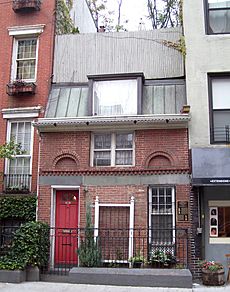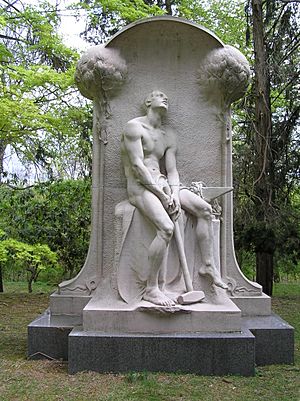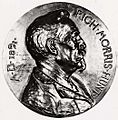Karl Bitter facts for kids
Karl Theodore Francis Bitter (born December 6, 1867 – died April 9, 1915) was an amazing sculptor. He was born in Austria but became an American citizen. He is most famous for his sculptures on buildings, his memorials, and his art for homes.
Contents
Life and Career of a Sculptor
Karl Bitter was born in Vienna, Austria. He started learning art at a young age. First, he went to a school for applied arts. Then, he studied at the Academy of Fine Arts in Vienna.
After finishing school, he worked for a sculptor who made art for buildings. This was a busy time in Vienna. Many new buildings were being built along the Vienna Ring Road, and they all needed beautiful decorations.
Karl had to leave Austria for a while because of a military situation. He couldn't go back for many years. Later, the Emperor of Austria, Franz Joseph I of Austria, forgave him. The Emperor hoped Karl would return to Vienna because he was so famous.
In 1889, Karl Bitter moved to the United States. He arrived in New York City and decided to become an American citizen. He started working as an assistant for a company that decorated houses.
When he was just 21, he entered a competition. He won the job to create the bronze gates for Trinity Church in New York. This important project gave him enough money to open his own small art studio.
Karl Bitter created many famous statues. He made seated statues of Thomas Jefferson and Alexander Hamilton for the Cuyahoga County Courthouse in Cleveland, Ohio. He showed them as younger men, from when they had different ideas about America's future.
Later, Missouri asked for a copy of the Jefferson statue. Karl changed it slightly to show Jefferson as he looked when he signed the Louisiana Purchase agreement. For the University of Virginia, he made Jefferson look even older, as he did in his retirement.
A famous architect named Richard Morris Hunt discovered Karl Bitter's talent. From then on, Karl always had work. He became a very important person in the art world.
He helped organize the sculpture exhibits at big events. These included the World's Columbian Exposition in Chicago in 1893 and the Pan-American Exposition in Buffalo in 1901. He also led the sculpture programs for the 1904 Louisiana Purchase Exposition in St. Louis and the 1915 Panama–Pacific International Exposition in San Francisco.
Karl Bitter won many awards for his art. He received silver and gold medals at different expositions. He was also a member of important art groups, like the National Academy of Design.
Karl's art style was changing. He started with classic, realistic sculptures. But he was moving towards more modern ideas. Sadly, we'll never know where his art would have gone. In 1915, he was leaving the Metropolitan Opera in New York. A car jumped onto the sidewalk and hit him. He pushed his wife out of the way, saving her life.
Like many artists of his time, Karl Bitter often worked with Audrey Munson. She was a famous model. On June 30, 1901, he married Marie A. Schevill. They had three children. Their son, Francis Bitter, grew up to be a well-known physicist.
For a while, Karl Bitter's studio was in a building called The Castle. This building was part of the Eldorado Amusement Park in Weehawken, New Jersey.
Sculptures on Buildings

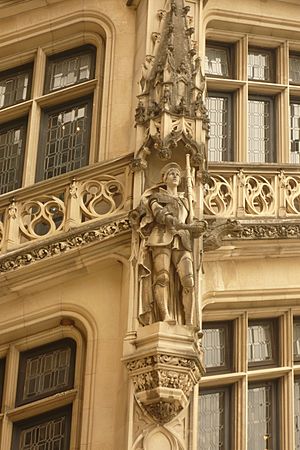
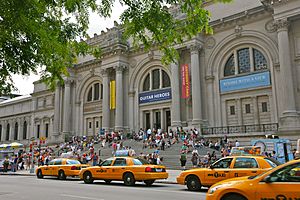
Karl Bitter created many sculptures that were part of buildings. This is called architectural sculpture. Here are some examples:
- East Doors and Tympanum (the decorated space above a doorway), Trinity Church, New York, 1891.
- Elements Controlled and Uncontrolled (1893) for the Administration Building at the World's Columbian Exposition in Chicago. This sculpture was later destroyed.
- For the Broad Street Station in Philadelphia (1894):
- Spirit of Transportation (a large plaster sculpture) is now at 30th Street Station.
- He also made large sculptures for the outside of the building, but they were destroyed.
- For the Horace Jayne House in Philadelphia (1895), he made four relief panels (sculptures that stick out from a flat surface) of musicians.
- For the Biltmore Estate in North Carolina (1895), he created:
- A large statue of Joan of Arc on the outside staircase.
- A large statue of St. Louis on the outside staircase.
- An oak frieze (a long, narrow sculpture) called Contest of the Minstrels.
- A stone frieze called The Return from the Chase.
- A bronze sculpture called Boy Stealing Geese for a fountain.
- For the Metropolitan Museum of Art in New York City:
- Six round portrait medallions (like large coins with faces) above the main entrance. These show famous artists.
- Four caryatids (sculpted female figures used as columns) on the Fifth Avenue side. These represent Painting, Sculpture, Architecture, and Music.
- For the St. Paul Building in New York City (1896), he made three caryatids. When the building was torn down, these sculptures were moved to Holliday Park in Indianapolis.
- He made decorations for the Dewey Arch in New York (1899).
- He created the Cornell Memorial Pulpit and Choir Rail (1900) for All Angels' Episcopal Church. This is now at the Metropolitan Museum of Art.
- He worked on the Alexander Hamilton U.S. Custom House in New York (1906).
- He made sculptures for the Cleveland Trust Company (1907) and the First National Bank (1908) in Cleveland, Ohio.
- He created four eagles and four globes (1909) for the Monument to United States Regulars at Gettysburg National Military Park.
- For the Cuyahoga County Courthouse in Cleveland, Ohio:
- Statues of Lord John Somers and Lord Mansfield (1911) on top of the building.
- For the Wisconsin State Capitol in Madison, Wisconsin:
- Liberty Supported by the Law (1910) on the East Pediment (the triangular part above the entrance).
- Wisconsin State Resources (1917) on the West Pediment.
- Four sculpture groups (1912) around the base of the dome: Knowledge, Strength, Faith, and Prosperity and Abundance.
Monuments and Other Artworks
Karl Bitter also created many standalone monuments and other works:
- A bronze statue of Dr. William Pepper (1895) at the University of Pennsylvania. Another version is at the Free Library of Philadelphia (1899).
- The Breckenridge Memorial Tablet (1902) at the United States Naval Academy.
- Signing the Treaty (later called Louisiana Purchase Group) (1904) for the Louisiana Purchase Exposition in St. Louis. A bronze version was made in 1913 for the Missouri History Museum.
- An equestrian (on horseback) statue of General Franz Sigel (1907) in Riverside Park, New York City.
- The William Henry Baldwin Jr. Memorial Tablet (1909) at Tuskegee University.
- The Dr. James Burrill Angell Memorial Tablet (1909) at the University of Michigan.
- Bronze statues of Alexander Hamilton (1911) and Thomas Jefferson (1911) for the Cuyahoga County Courthouse in Cleveland, Ohio.
- A marble statue of Thomas Jefferson (1913) for the Missouri History Museum.
- A bronze statue of Thomas Jefferson (1915) for the University of Virginia. Another version is at Jefferson High School in Portland, Oregon.
- The Henry Philip Tappan Memorial (1913) at the University of Michigan.
- The Carl Schurz Monument (1913) in Morningside Park, New York City. Another version is in Menominee Park, Oshkosh, Wisconsin (1914).
- The Thomas Lowry Monument (1915) in Minneapolis.
- A bronze statue of Andrew Dickson White (1915) at Cornell University in Ithaca, New York.
Art for Gravesites
Karl Bitter also designed sculptures for memorials in cemeteries:
- Thanatos (1903), a bronze sculpture for the John Erastus Hubbard Memorial.
- The End of the Day's Work (1904), a marble sculpture for the Henry Villard Memorial.
- Faded Flowers (1911), a marble sculpture for the Prehn Mausoleum.
Works Finished After His Death
Some of Karl Bitter's works were completed by other sculptors after he passed away:
- Pomona (1916), a bronze statue for the Pulitzer Fountain in New York City. It was finished by Isidore Konti and Karl Gruppe.
- Depew Memorial Fountain (1919), a bronze fountain in Indianapolis. It was completed by Alexander Stirling Calder.
- The Louisiana Purchase Group (by 1929), a bronze sculpture at the Missouri State Capitol.
- A large bronze statue of Henry Hudson (1939) in New York City. This was started in 1909 and finished by Isidore Konti and Karl Gruppe using Bitter's original model.
Gallery
-
Spirit of Transportation (1894) at 30th Street Station, Philadelphia
-
Dr. William Pepper (1899) at the Free Library of Philadelphia
-
Symbols of Government (1907) at the Alexander Hamilton U.S. Custom House, New York
-
Wisconsin State Capitol (1908–1912) in Madison, Wisconsin
-
Thomas Jefferson (1909–1911) at Cuyahoga County Courthouse, Cleveland, Ohio
-
Carl Schurz Monument (1913) in Morningside Park, Manhattan
-
Thomas Lowry Memorial (1915) in Minneapolis
-
Andrew Dickson White statue (1915) at Cornell University, Ithaca, New York




